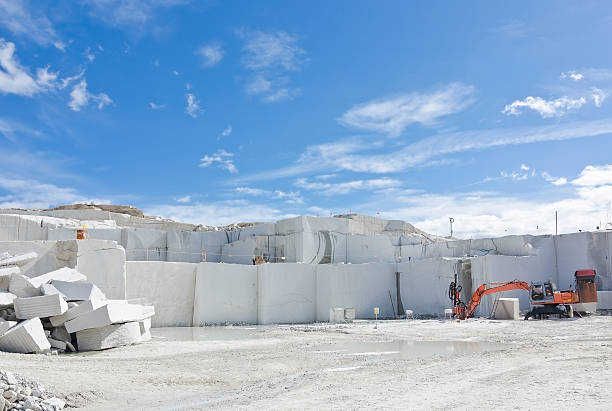A Journey Through Granite Quarries in South Africa: Introduction Nature's Virtuosity
A Journey Through Granite Quarries in South Africa: Introduction Nature's Virtuosity
Blog Article
Discovering the Rich Background and Sustainable Practices of Granite Quarrying
As we depend on the precipice of uncovering the detailed tapestry of granite quarrying, a journey with time reveals not just the physical act of removing stone however additionally the cultural and historical relevance woven right into the extremely textile of this method. From the ancient beginnings that laid the foundation for contemporary quarrying strategies to the lasting practices that are forming the future of this sector, each chisel mark on granite surface areas narrates waiting to be discovered (granite quarries in south africa). The legacy of granite quarrying extends much past mere extraction; it is a testament to human resourcefulness, strength, and the enduring allure of this impressive stone
Ancient Origins of Granite Quarrying
Dating back to ancient human beings, the technique of quarrying granite has been an essential component of human background and building innovation. The earliest proof of granite quarrying go back to old Egypt, where huge pyramids and complex sculptures were crafted from this long lasting rock. The Egyptians made use of primitive devices to remove granite blocks from quarries, showcasing the relevance of this product in their monumental constructions.
Moving on in history, the Greeks also made significant contributions to the quarrying of granite. The Greeks used granite in various building wonders, such as holy places and statuaries, showing their ability in shaping and carving this sturdy stone. The Romans even more fine-tuned the methods of quarrying granite, employing advanced tools like chisels and hammers to remove and shape granite for their iconic frameworks.
Via the centuries, the technique of quarrying granite has actually developed, with modern technologies boosting performance while preserving the ageless appeal of this all-natural rock - granite quarries in south africa. From ancient civilizations to modern builders, the heritage of granite quarrying remains to shape our globe
Advancement of Quarrying Methods
The evolution of quarrying strategies has been noted by a continuous development in the direction of higher performance and accuracy in drawing out granite. Early quarrying techniques included hands-on labor with standard tools such as blades, hammers, and wedges to extract granite blocks from the earth.
In even more recent times, the development of equipment transformed the quarrying sector, enabling quicker removal prices and increased efficiency. Technologies such as ruby wire saws, high-pressure water jets, and pneumatic drills have actually come to be basic in modern-day quarries, enabling precise cutting and minimized waste. Innovations in computer-controlled tools and 3D modeling have optimized quarrying operations, leading to minimal environmental effect and enhanced sustainability methods. As the need for granite proceeds to increase, the development of quarrying strategies continues to be important to conference industry needs successfully discover this and sustainably.
Cultural Significance of Granite
Granite holds a profound social value throughout different worlds due to its long-lasting visibility in building masterpieces and revered monoliths. From the majestic pyramids of Egypt to the detailed makings of the Angkor Wat temple in Cambodia, granite has been a product of option for expressing grandeur and long life in social heritage. In ancient Rome, granite columns adorned holy places and public structures, symbolizing toughness and permanence. The cultural value of granite prolongs beyond its physical attributes; it personifies durability, stability, and eternity, making it a symbol of sustaining traditions and traditions.

Lasting Practices in Quarrying
Amidst the abundant history of granite quarrying and its cultural value exists a growing focus on sustainable practices within the sector. As environmental awareness and worries regarding resource exhaustion have enhanced internationally, the quarrying industry has actually progressively embraced lasting methods to decrease its effect on the setting and surrounding areas.

Additionally, improvement and rehabilitation of quarry sites post-extraction are integral to sustainable practices. By bring back quarried locations to an all-natural or beneficial state, such as creating wild animals environments or entertainment rooms, quarriers can balance out the environmental footprint of their operations and add favorably to the regional environment.
Tradition of Granite Quarrying
With a historical background soaked in craftsmanship and industrial progression, what sustaining effect has granite quarrying left on the landscape of contemporary society? The heritage of granite quarrying goes beyond mere extraction techniques; it has actually formed architectural marvels, city landscapes, and social heritage worldwide. The resilient nature of granite has made it a recommended option for monuments, structures, and facilities, standing as a testament to the ability and creativity of quarry employees throughout generations.
Furthermore, the financial footprint of granite quarrying can not be overlooked. The sector remains to provide work chances and drive local economic situations in regions where granite extraction is widespread. It has additionally spurred technological innovations in quarrying methods and tools, causing more effective and sustainable methods.
In terms of sustainability, the tradition of granite quarrying consists of efforts to alleviate ecological influences through improvement tasks and responsible resource administration. By stabilizing financial interests with environmental stewardship, the market makes every effort to ensure that future generations can remain to gain from this long-lasting natural deposit.
Conclusion

Report this page